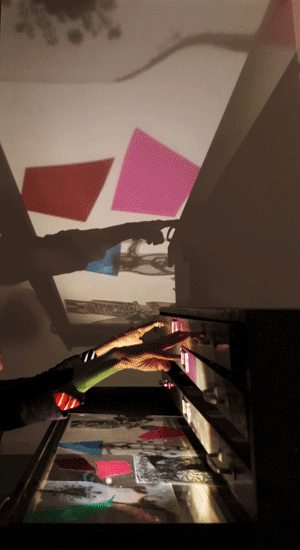Ofri Cnaani, Flat Files, 2015, digital image © Ofri Cnaani.
Ofri Cnaani, File Under: ?
December 12, 2015 – January 30, 2016
Equity Gallery, 245 Broome Street, New York, NY 10002
Opening Reception: Saturday, December 12, 2015, 6-8pm
“Help Desk” Performance: Saturday, January 16, 2016, 12-4pm
Gallery Hours: Wednesday-Saturday, 11am-6pm, and by appointment
New York, New York, November 17, 2015 – Equity Gallery is pleased to announce File Under: ?, a solo exhibition by Ofri Cnaani running from December 12, 2015 to January 30, 2016, with an opening reception for the public on Saturday, December 12, 6-8pm and a performance on Saturday, January 16, 2016, 12-5pm.
For Equity Gallery’s second exhibition, Cnaani will take over the non-profit art space, creating a participatory piece that functions as a visualization of Artists Equity's mission to support artists.
Artists Equity was founded in 1947 when over 160 leading artists banded together to establish and protect artists' rights. To define the organization’s mission, the founders asked questions of themselves, their friends and advisors, focusing on what could be achieved when artists come together. Cnaani was inspired by this history of collaboration and advocacy to create this exhibition and its related events.
Artists address theoretical, conceptual and political questions in their work, but what of the other questions in their lives as artists? From November through January, Cnaani invites all artists to submit such questions – the burning questions that each individual artist wants answered to help him/her. All topics are welcome: from career advice to health insurance to copyright law to housing – whether philosophical, trivial or deeply personal. These questions will be collected, displayed and discussed in a variety of ways at Equity Gallery and through online platforms.
Questions can be submitted via email to info@nyartistsequity.org, via Twitter and Instagram with the hashtag #artistquestion or anonymously via Artists Equity’s website at nyartistsequity.org/questions.
Throughout the run of the exhibition, the rear gallery will become an immersive space that draws upon Cnaani’s selection of visuals and documents from the Artists Equity archive and the questions of artists from the past. She will turn a file cabinet into a projection system filling the space with shadows and colors. Based on Cnaani’s selections, viewers will be able to explore the “visual files” firsthand, and through their interaction modify the projection of the archive.
On January 16, 2016, between 12pm and 4pm, experts from a variety of fields will be on hand at the gallery at Cnaani’s “help desk marathon” – a performance that presents itself as an opportunity of equity exchange – where as many of the artists’ questions as possible will be answered. The answers to the artists’ questions will be transcribed, processed and made available through Artists Equity’s website as a service for the art community. Furthermore, these concerns will be analyzed in order to shape the organization’s future programming.
File Under: ? not only aims to challenge artists to focus on the essential needs of their practices, but looks to raise awareness of artists’ concerns when they are free to ask absolutely anything.
About Artists Equity
New York Artists Equity Association, Inc. is a 501(c)(3) non-profit organization founded in 1947 by artists and art patrons with the mission to promote opportunities for artists. It operates Equity Gallery, an art space located on the Lower East Side of New York City. For more information, please visit www.nyartistsequity.org.
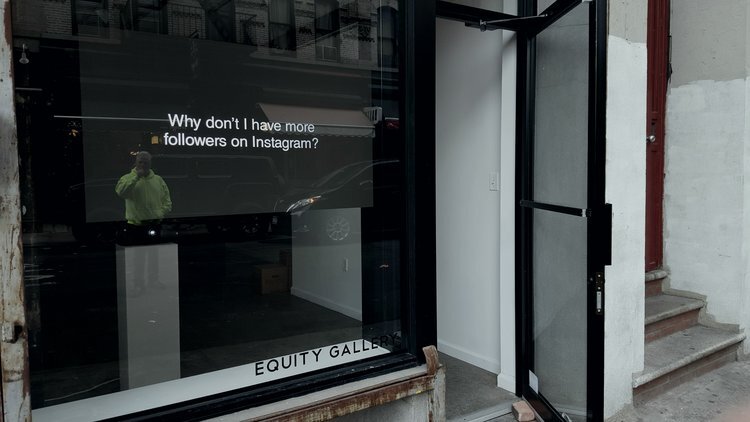
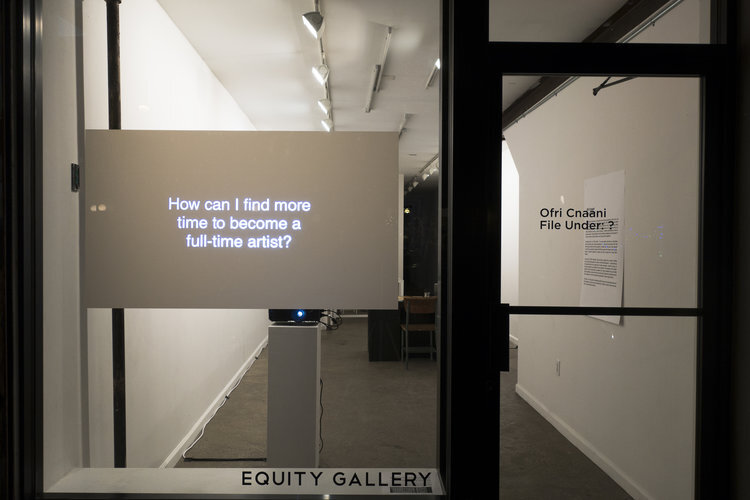
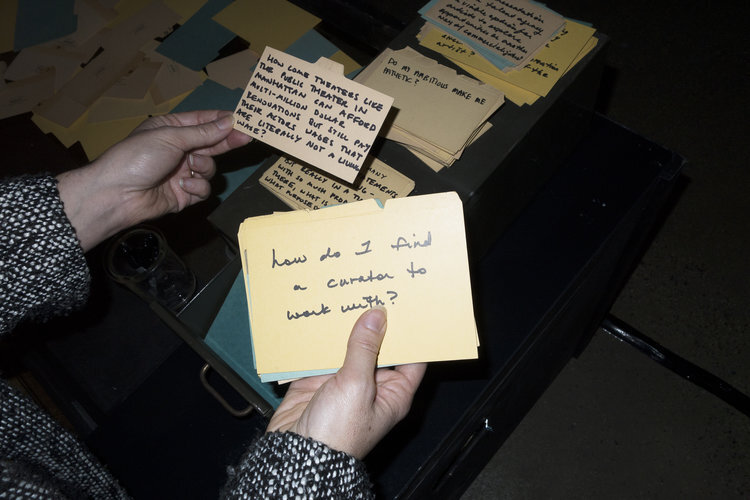

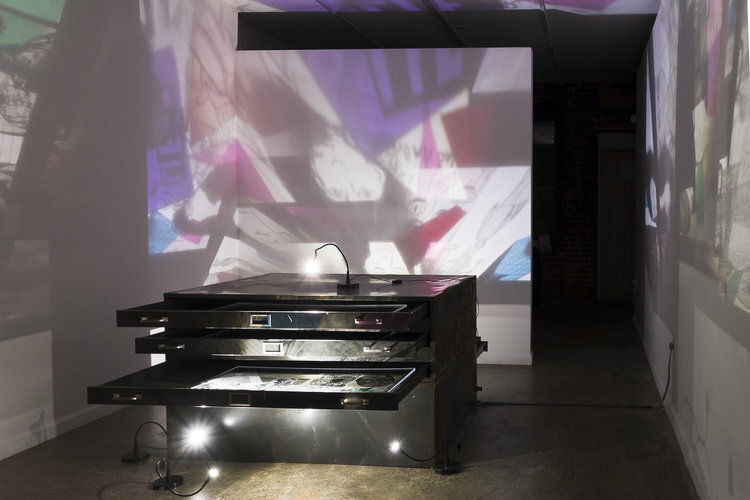

Ofri Cnaani
File Under: ?
Roxana Fabius
Rifling through archive boxes can be like discovering a buried treasure from long lost childhood adventures, bringing to light unexpected valuables contained within those cardboard walls, accumulated by a group of peers looking to create an enterprise with a purpose.
The archives of New York Artists Equity Association (Artists Equity) inspire the exhibition File Under: ?. Artworks, letters, petitions, photographs, memorandums and even congressional proceedings enter into the works created by Ofri Cnaani for the second exhibition at Equity Gallery.
Artists Equity was founded as a “non-political, non-partisan organization representing professional fine artists. It was formed to further and protect the creative and economic interests and rights of artists and to give strength and effectiveness to their united professional aims.” At the end of the Works Progress Administration (WPA) era of government patronage, artists recognized the need to create an association dedicated to defending their interests, chiefly by framing them in economic and legal terms. Amidst an increasingly tense political climate, Artists Equity defined itself as accepting artists from all points in the spectrum, both politically and aesthetically.
The projects that Artists Equity engaged with ranged from lobbying with a petition to the Pepsi Corporation signed by most members, expressing their intention to boycott the 1947 Pepsi-Cola art competition unless participation fees were paid to each exhibiting artist, to commissioning works for window displays for Saks Fifth Avenue in the 1950s, including artists like Chaim Gross and David Smith. Notably, they also advocated for artists’ royalties on the event of resales in the 1980s. Even though the organization did not identify with specific aesthetic movements, it did encourage the creation of spaces of dialogue about issues that mattered to artists at the time, creating “a regular opportunity to do one of the things everyone likes -- to talk” as Lincoln Rothschild, Executive Director for the National Board of Directors (and artist) writes in an Artists Equity memo from 1953. All these events and developments form the identity of Artists Equity and its archives.
In the formation of an archive, the way knowledge is produced and preserved is often the result of protocols created by negotiating through the politics of acquisition and access. Predicting the historical context of an object, for example, in relation to its contemporary relevance is a tricky process. Hanging in the balance are accepted norms, testaments to the ebb and flow of cultural trends, language-image turns and moral compasses. These processes of knowledge construction are strikingly revelatory in an era of data politics, when enigmatic databases store massive amounts of information for unspecified purposes. What can an object, a data string or, in this case, a collection in a public archive, reveal about the temporalities and cultural ideologies which traverse through it? This is a key question that File Under: ? aims to ask about the history, present and future of Artists Equity.
Cnaani first developed her way of processing materials to read the archives and personal papers of her grandfather, sculptor Yechiel Shemi. For that reading, Cnaani created a projection system described by curator Hadas Keidar as “Locked Screens,” since it provided a static visual expression of the aforementioned documents. At Equity Gallery, the rules of the game are different. Encompassed with the original aims of Artists Equity, artists and art patrons are invited to take part in the process of visual interpretation by accessing the existing archives as well. According to Professor Ernst van Alphen’s book, Staging the Archive, archivists “are no longer the passive guardians of an inherited legacy. They are now seen as active agents who shape cultural and social memory. Whereas archivists were until recently information technologists embracing the notion of the archive as neutral, even mechanical accumulation of information, now they have become cultural analysts conceiving the archive as storage of information as well as a source of knowledge and power essential for social and personal identity.” [1] This new role of the archivist is appropriated by the artist who analyzes existing materials and generates a personal methodology of visualization of the Artists Equity archive.
Cnaani draws on documents that demonstrate how these artists were once working for the collective aim of building new forms of representation. In this exhibition, every visitor to Equity Gallery can contribute to this aim by interpreting the archive’s content as well as proposing its future purpose and defining what the next viewer should understand when they encounter this file. Thus the archive becomes alive again and presents a space of creation, an opportunity to organize a new collective. In each individual reading, there is a new experience, a new message.
In this age of financial, housing and health insecurity, the original aim of Artists Equity is as relevant as it was in 1947. This is why File Under: ? invites you to imagine possible futures through re-interpreting the archive and helping to define the organization’s present day mission. As part of the exhibition, artists can submit their urgent concerns, which will be answered at Cnaani’s “Help Desk Marathon”. On January 16, 2016, between 12pm and 5pm, experts from a variety of fields will be on hand at the gallery responding to the submitted questions. The performance presents itself as an opportunity of equity exchange, where as many of the artists’ questions as possible will be answered. These answers will be transcribed, processed and made available through Artists Equity’s website as a service to the art community. Furthermore, these concerns will be analyzed in order to shape the organization’s future programming. As the early motto of Artists Equity proclaimed, “You need Equity. . . Equity needs you.”
[1] Van Alphen, Ernst, Staging the Archive, Reaktion Books, London, 2014, p14.
Call for Questions
Is New York City still the best place for artists to live? How do I get more people to see my work? How do I get health insurance? If I’m so smart, why aren’t I more successful?
What are the burning questions on your mind these days?
Artist Ofri Cnaani and Artists Equity ask you to take a minute to send us one or more questions that represent constant concerns and constitute the most pressing issues in your current state of affairs. Artists address theoretical, conceptual and political questions in their work, but what of the other burning questions in their lives as artists? This is an opportunity to ask the questions that are raised in your practice and life as a working artist. From health insurance to royalties, from childcare to elderly communities, housing to networking -- whether philosophical, trivial or deeply personal, please share with us your question marks.


